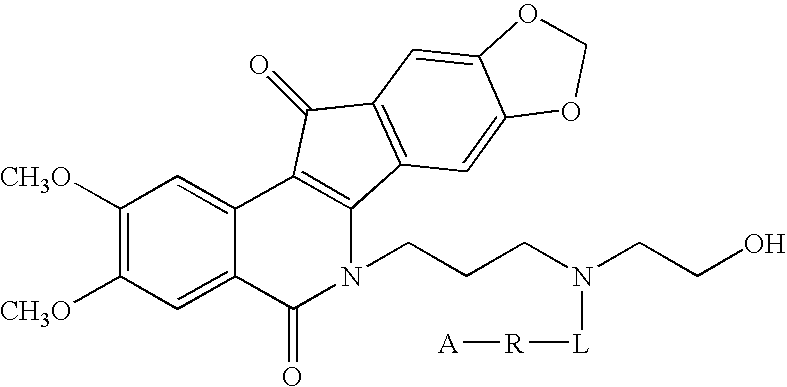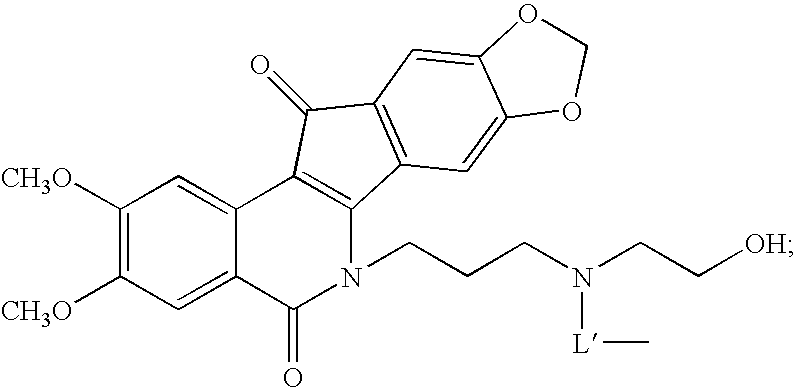Indenoisoquinoline-releasable polymer conjugates
- Summary
- Abstract
- Description
- Claims
- Application Information
AI Technical Summary
Benefits of technology
Problems solved by technology
Method used
Image
Examples
example 1
General
[0176]All reactions were conducted under an atmosphere of dry nitrogen. Commercial regents and anhydrous solvents were used without further purification. Indenoisoquinoline compound (IndQ, MJ III 65 or NSC 706744) was supplied by National Cancer Institute and Purdue University. NMR spectra were recorded at a Varian Mercury 300 MHz NMR spectrometer using deuterated solvent indicated. Chemical shifts (d) are reported in parts per million (ppm) downfield from tetramethylsilane (TMS) and coupling constants (J values) are given in hertz (Hz). Reaction progress and in vitro hydrolysis of PEGylated Indenoisoquinoline in rat plasma were monitored by a Waters 2420 HPLC with a UV detector monitored at 275 nm, on a Phenomenex Jupiter 300A 250×4.6 mm C18 column using a linear gradient of acetonitrile in water with 0.05% TFA. Mass spectra were obtained from an Agilent Mass Spectrometer.
example 2
Compound 1
[0177]A solution of 4-hydroxylbenzyl alcohol (10.0 g, 80.6 mmol) and tert-butyldimethylsilyl chloride (13.4 g, 88.9 mmol) in DMF (50 mL) was cooled to 0° C. in an ice bath, followed by addition of a solution of TEA (44.6 mmol) in DMF (100 mL). The reaction mixture was allowed to warm up to room temperature and stirred over night. After the reaction completion was con filmed by TLC, the reaction mixture was concentrated by evaporation under reduced pressure, followed by extraction with DCM (200 mL) and 10% NaHCO3 (150 mL). The organic layer was dried over anhydrous MgSO4, and concentrated by rotary evaporation. This product was further purified by chromatography on silica gel to give compound 1 (9.5 g): 1H NMR (300 MHz, CDCl3) d 7.08 (d, 2H, J= 8.3), 6.67 (d, 2H, J= 8.4), 4.99 (s, 1H), 4.57 (s, 1H), 0.93 (s, 9H), 0.091 (s, 6H); 13C NMR (75.4 MHz, CDCl3) d 154.4, 133.4, 127.8, 115.0, 64.8, 26.0, 18.5, −5.1.
example 3
Compound 2
[0178]Disuccinimidyl carbonate (DSC, 0.70 g, 2.73 mmol) was suspended in chloroform (50 mL) containing compound 1 (0.71 g, 3.0 mmol) and pyridine (0.26 mL, 3.25 mmol). The mixture was refluxed overnight, then cooled to room temperature, followed by addition of a solution of 40kPEG-(NH2)2 (10 g, 0.25 mmol) and pyridine (0.26 mL, 3.25 mmol) in DMF (30 mL). The reaction mixture was stirred at room temperature overnight, and the mixture was concentrated by evaporation under reduced pressure. The crude product was precipitated by ether, subjected to crystallization from 20% DMF / IPA to give compound 2 (9.5 g): 13C NMR (75.4 MHz, CDCl3) d 154.5, 149.6, 138.0, 126.6, 121.1, 64.3, 40.9, 25.9, 18.3, −5.2.
PUM
| Property | Measurement | Unit |
|---|---|---|
| Mass | aaaaa | aaaaa |
| Mass | aaaaa | aaaaa |
| Mass | aaaaa | aaaaa |
Abstract
Description
Claims
Application Information
 Login to View More
Login to View More - Generate Ideas
- Intellectual Property
- Life Sciences
- Materials
- Tech Scout
- Unparalleled Data Quality
- Higher Quality Content
- 60% Fewer Hallucinations
Browse by: Latest US Patents, China's latest patents, Technical Efficacy Thesaurus, Application Domain, Technology Topic, Popular Technical Reports.
© 2025 PatSnap. All rights reserved.Legal|Privacy policy|Modern Slavery Act Transparency Statement|Sitemap|About US| Contact US: help@patsnap.com



